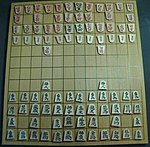Hexshogi

Hexshogi is a shogi variant for two players created by George R. Dekle Sr. in 1986.[1][2] The gameboard comprises 85 hexagonal cells. The game is in all respects the same as shogi, except that piece moves have been transfigured for the hexagonal board-cell geometry.
Hexshogi was included in World Game Review No. 10 edited by Michael Keller.[3]
Game rules
[edit]Hexshogi has the same types and numbers of pieces as shogi, and all normal shogi rules apply, including a similar initial setup (see diagram), drops, promotion, check, checkmate, and impasse. As in shogi, pieces capture the same as they move. But the hexagonal geometry implies special move patterns for the pieces.
Piece moves
[edit]The diagrams show how the unpromoted pieces move. As in shogi, a dragon king (promoted rook) moves as a rook, or as a king. A dragon horse (promoted bishop) moves as a bishop or a king.
See also
[edit]- Gliński's hexagonal chess
- Also by George Dekle:
- Trishogi – a variant with triangular cells
- Masonic Shogi
- Space Shogi – a 3D variant
Notes
[edit]- ^ a b c d The Hexshogi rook, bishop, and king have the same moves as their counterpart pieces in Gliński's hexagonal chess. (Also the Hexshogi knight, except that the knight is restricted, as in shogi, to the two most straight-forward moves.) (Pritchard 2007:260)
References
[edit]- ^ Pritchard (1994), p. 145
- ^ Pritchard (2007), p. 260
- ^ Keller, Michael, ed. (June 1991). "A Panorama of Chess Variants". World Game Review. No. 10. Michael Keller. ISSN 1041-0546.
Bibliography
- Pritchard, D. B. (1994). The Encyclopedia of Chess Variants. Games & Puzzles Publications. ISBN 0-9524142-0-1.
- Pritchard, D. B. (2007). Beasley, John (ed.). The Classified Encyclopedia of Chess Variants. John Beasley. ISBN 978-0-9555168-0-1.
External links
[edit]- Hex Shogi variants by Fergus Duniho, The Chess Variant Pages
Standard shōgi (9×9, drops) | ||
| Small variants |
|  |
| Standard-size variants |
| |
| Large variants |
| |
| Multiplayer variants |
| |
| 3D variants |
| |
| Miscellaneous variants |
| |
Text is available under the CC BY-SA 4.0 license; additional terms may apply.
Images, videos and audio are available under their respective licenses.


